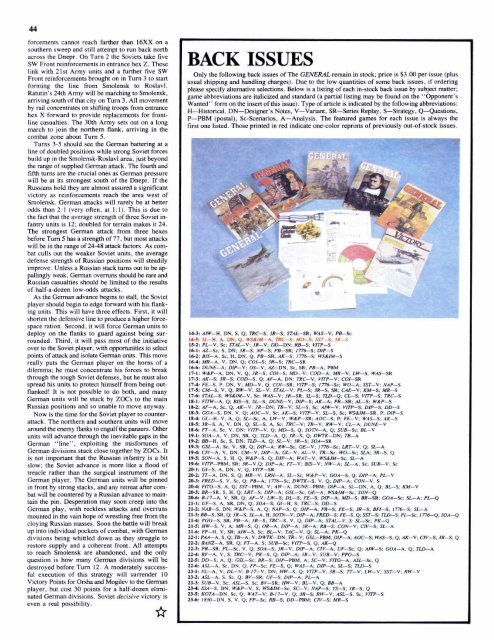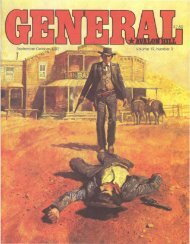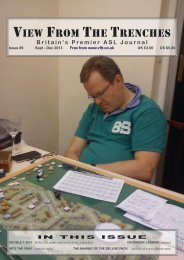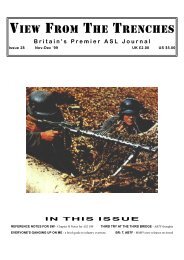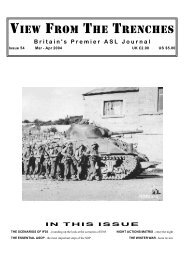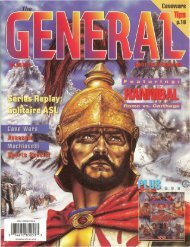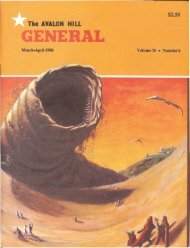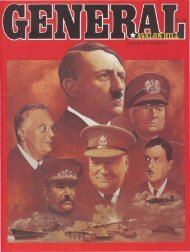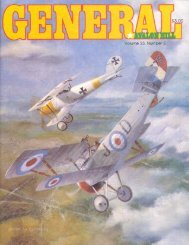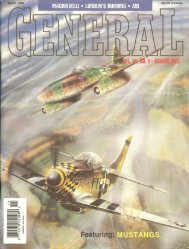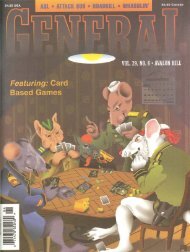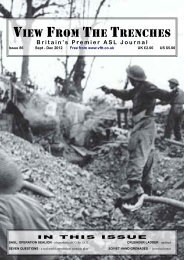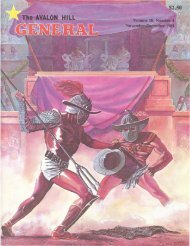Create successful ePaper yourself
Turn your PDF publications into a flip-book with our unique Google optimized e-Paper software.
forcements cannot reach farther than 16XX on a<br />
southern sweep and still attempt to run back north<br />
across the Dnepr. On Turn 2 the Soviets take five<br />
SW Front reinforcements in entrance hex Z. <strong>The</strong>se<br />
link with 21st Army units and a further five SW<br />
Front reinforcements brought on in Turn 3 to start<br />
forming the line from Smolensk to Roslavl.<br />
Ratutin's <strong>24</strong>th Army will be marching to Smolensk,<br />
arriving south of that city on Turn 3. All movement<br />
by rail concentrates on shifting troops from entrance<br />
hex X forward to provide replacements for front-<br />
line casualties. <strong>The</strong> 30th Army sets out on a long<br />
march to join the northern flank, arriving in the<br />
combat zone about Turn 5.<br />
Turns 3-5 should see the German battering at a<br />
line of doubled positions while strong Soviet forces<br />
build up in the Smolensk-Roslavl area, just beyond<br />
the range of supplied German attack. <strong>The</strong> fourth and<br />
fifth turns are the crucial ones as German pressure<br />
will be at its strongest south of the Dnepr. If the<br />
Russians hold they are almost assured a significant<br />
victory as reinforcements reach the area west of<br />
Smolensk. German attacks will rarely be at better<br />
odds than 2:l (very often, at 1:l). This is due to<br />
the fact that the average strength of three Soviet in-<br />
fantry units is 12; doubled for terrain makes it <strong>24</strong>.<br />
<strong>The</strong> strongest German attack from three hexes<br />
before Turn 5 has a strength of 77, but most attacks<br />
will be in the range of <strong>24</strong>-48 attack factors. As com-<br />
bat culls out the weaker Soviet units, the average<br />
defense strength of Russian positions will steadily<br />
improve. Unless a Russian stack turns out to be ap-<br />
pallingly weak, German overruns should be rare and<br />
Russian casualties should be limited to the results<br />
of half-a-dozen low-odds attacks.<br />
As the German advance begins to stall, the Soviet<br />
player should begin to edge forward with his flank-<br />
ing units. This will have three effects. First, it will<br />
shorten the defensive line to produce a higher force-<br />
space ration. Second, it will force German units to<br />
deploy on the flanks to guard against being sur-<br />
rounded. Third, it will pass most of the initiative<br />
over to the Soviet player, with opportunities to select<br />
points of attack and isolate German units. This move<br />
really puts the German player on the horns of a<br />
dilemma; he must concentrate his forces to break<br />
through the tough Soviet defenses, but he must also<br />
spread his units to protect himself from being out-<br />
flanked! It is not possible to do both, and many<br />
German units will be stuck by ZOCs to the main<br />
Russian positions and so unable to move anyway.<br />
<strong>No</strong>w is the time for the Soviet player to counter-<br />
attack. <strong>The</strong> northern and southern units will move<br />
around the enemy flanks to engulf the panzers. Other<br />
units will advance through the inevitable gaps in the<br />
German "line", exploiting the misfortunes of<br />
German divisions stuck close together by ZOCs. It<br />
is not important that the Russian infantry is a bit<br />
slow; the Soviet advance is more like a flood of<br />
treacle rather than the surgical instrument of the<br />
German player. <strong>The</strong> German units will be pinned<br />
in front by strong stacks, and any retreat after com-<br />
bat will be countered by a Russian advance to main-<br />
tain the pin. Desperation may soon creep into the<br />
German play, with reckless attacks and overruns<br />
mounted in the vain hope of wrestling free from the<br />
cloying Russian masses. Soon the battle will break<br />
up into individual pockets of combat, with German<br />
divisions being whittled down as they struggle to<br />
restore supply and a coherent front. All attempts<br />
to reach Smolensk are abandoned, and the only<br />
question is how many German divisions will be<br />
destroyed before Turn 12. A moderately success-<br />
ful execution of this strategy will surrender 10<br />
Victory Points for Orsha and Mogilev to the German<br />
player, but cost 30 points for a half-dozen elirni-<br />
nated German divisions. Soviet decisive victory is<br />
even a real possibility. *<br />
a 1<br />
BACK ISSUES<br />
Only the following back issues of <strong>The</strong> GENERAL remain in stock; price is $3.00 per issue (plus<br />
usual shipping and handling charges). Due to the low quantities of some back issues, if ordering<br />
please specify alternative selections. Below is a listing of each in-stock back issue by subject matter;<br />
game abbreviations are italicized and standard (a partial listing may be found on the "Opponent's<br />
Wanted" form on the insert of this issue). Type of article is indicated by the following abbreviations:<br />
H-Historical, DN-Designer's <strong>No</strong>tes, V-Variant, SR-Series Replay, S-Strategy, Q-Questions,<br />
P-PBM (postal), Sc-Scenarios, A-Analysis. <strong>The</strong> featured games for each issue is always the<br />
first one listed. Those printed in red indicate one-color reprints of previously out-of-stock issues.<br />
14-3: AIW-H, DN, S, Q; TRC-S; 3R-S; STAL-SR; WAS-V; PB-Sc<br />
1U: SGH. A, DN. Q; WSIM-A; TRC-S; MD-S; ST-S; 3R-1<br />
15-2: PL-V. Sc; STAL-V; 3R-V; DD-DN; RE-S; VJP-S<br />
16-1: AZ-Sc, S, DN; 3R-S; NP-S; PB-SR; I77.5-S; DIP-S<br />
16-2: BIS-A, Sc, H. DN, Q; PB-SR; AK-S; I776-S; WS&IM-S<br />
la MR-A, V, DN, Q; COI-S; 3R-S; TRC-SR<br />
166: DUNE-A; DIP-V; OS-V; AZ-DN, Sc, SR; PB-A, PBM<br />
17-1: W&P-A, DN, V, Q; 3R-S; COI-S; MD-V; COD-A; MR-V; LW-S; WAS-SR<br />
17-3: AK-S; 3R-S; COD-S, Q; AF-A, DN; TRC-V; VITP-V; COI-SR<br />
174 FE-S, P, DN, V; MD-V, Q; COI-SR; VITP-S; 1776-Sc; WO-A; SST-V; NAP-S<br />
17-5: CM-S, V, Q; RW-V; SL-V; STAL-V; PL-S; 3R-S, SR; CAE-V; KM-S; MR-S<br />
17-6: STAGS; WMIM-V, Sc; WAS--V; 3R-SR; SGS; TLI)--Q; CL-S; VITP-S; TRC-S<br />
18-1: FW-A, Q; BIS-S; SL-S; DUNE-V; DIP-S; AK-A; PB-SR; AL-S; W&P-S<br />
18-2: AF-A, Sc, Q; AK-V; 3R-DN; TB-V; SGS, Sc; AIW-V; VITP-S; DIP-S; DD-S<br />
18-3: WA-S. DN, V, Q; AOC-V, Sc; AK-S; VITP-V; SL-S, Sc; WS&IM-SR, P; DIP-S<br />
184: GL-H, V, A. Q; SL-Sc, A; LW-V; W&P-SR; AOC-S, P; FE-V; WAS-S; AK-S<br />
18-5: 3R-S. A, V, DN, Q; SL-S, A, Sc; TRC-V; TB-V; RW-V; CL-A; DUNE-V<br />
164 FT-A. Sc, V, DN; VITP-V, Q; MD-S, Q; SOlN-A, Q; SUB-Sc; EL-V<br />
19-1: SOA-A, V, DN, SR, Q; -A, Q; 3R-S, Q; DWTK-DN; TB-A<br />
19-2: BE-H, Sc, S, DN; =A. Q; SGV; 3R-S; SOA-SR<br />
19-3: GSL-A, Sc, V, SR, Q; DIP-A; RW-Sc; GE-V; 17764~; LRT-V, Q; SL-A<br />
19-4: CW-A, V, DN; CM-V; DIP-A; GL-V; AL-V; TR-Sc; WO-Sc; SLA; 3R-S, Q<br />
19-5: SON-A, S, H, Q; W&P-S, Q; DIP-A; WAT-V; WS&IM-Sc; SL-A<br />
19-6: VITP-PBM, SR; 3R-V,Q; DIP-A; FT--V; BIS-V; NW-A; SL-A, Sc; SUB-V, Sc<br />
20-1: GI-S, A, DN, V, Q; VITP-SR<br />
20-2: lT-A. DN, S, Q; MR-V; LRH-A; SL-Sc; W&P-V; WA-S, Q; DIP-A; PL-V<br />
20-3: FRED-S, V, Sc, Q; PB-A; I776-Sc; DUTK-S, V, Q; DIP-A; CON-V, S<br />
20-4: FITG-S. A, Q; Sfl-PBM, V; AW-A; DUNE-PBM; DIP-A; SL-DN, A, Q; EL-S; KM-V<br />
30-5: BR-SR, S, H, Q; LRT-S; DIP-A; GSL-Sc; GE-A; WMIM-Sc; SON-Q<br />
2Bd: 8-1 7-A, V, SR, Q; AF-V; LW-S; DL-S; FE-S; DIP-A; MD-S; BR-SR; WA-Sc; SL-A; PL-Q<br />
21-1: UF-S, A, SR, DN, Q; SOA-S; GI-H, S; TRC-S; DD-S<br />
21-2: NAB-S, DN; W&P-S, A, Q; NAP--S, Q; DIP-A; FR-S; FE-S; 3R-S; BFI-S; 1776-8; SL-A<br />
21-3: BE-S, SR, Q; 3R-S; SL-A, H; SOlN-V; DIP-A; FRED-S; FE-S, Q; SST-S; TLD-S; PL-Sc; 1776-Q; SOA-Q<br />
214 PGG-S, SR; PB-A; 3R-S; TRC-S, V, Q; DIP-A; STAL-V, S; SGSc; PK-Q<br />
21-5: HW-S, V, A; MR-S, Q; OR-A; DIP-A; 3R-A; RE-S; CON-V; CW-S; SL-A<br />
21-6: FP-H, V, SR; AIW-S, Sc; BGV; TAC-V, Q; &-A; PK-Q<br />
22-1: PM-A, S, Q; TB-A, V; DWTK-DN; TR-V; GSL-PBM, DIP-A; AOC-S; WAS-S, Q; AK-V; CW-S; 3R-S, Q<br />
22-2: BAh%?-A, SR, Q; F7-A, S; SUB-Sc; VITP-S, Q; AK-Q<br />
22-3: PB-SR; PL-SC, V, Q; SOA-S; 3R-V; DIP-A; CW-A; UF-Sc, Q; AIW-S; GOA-A, Q; TLD-A<br />
2<strong>24</strong> RF-A, V, S; TRC-V; PK-S, Q; DIP-A; 3R-V; SUB-V; PPG--S<br />
22-5: DD--S. A, Q; GSL-Sc; BR-S; DIP-PBM, A; SC-V; FITG-A; ASGSc, Q<br />
22-6: ASL-A, Sc, DN, Q; FP-Sc; FE-S, Q; WAS-A; DIP-A; SL-S; TLD-S<br />
23-1: FL-A, V; DGV, B-17-V, DN; HW-S, Q; VITP-V; 3R-S; lT-V; LW-V; SST-V; RW-V<br />
23-2: ASGA, S, Sc, Q; BY-SR; UF-S; DIP-A; PL-A<br />
23-3: SUB-V, Sc; ASL-S, Sc; BY-SR; HW-V; EL-V, Q; BE-A<br />
234 ELI-S, DN; W&P-V, S; WSdrIM-Sc; SC-V; NAP-S; YS-S; 3R-S, Q<br />
23-5: KOTA-DN, Sc, Q; WAT-V; B-17-V, Q; 3R-S; RW-V; ASGS, Sc; VITP-S<br />
Ub: IUCLDN, S, V, Q; FP-Sc; RB-S; DD-PBM; CW-S; MR-S


